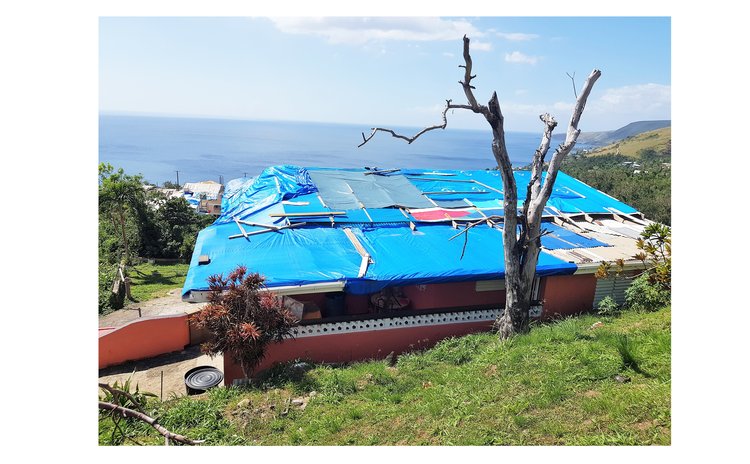Oh, Maria! You are Still Hurting Dominica
Dominicans assess their country's progress five years after Hurricane Maria

A surge of storm water wiped out almost everything in Henry Fountain's family home on September 18, 2017.
That was the day Hurricane Maria barreled through Dominica and changed the life of the 64-year-old father of four and many others.
A full five years later, Fountain's home still looks like a construction site- unfinished and barren.
"We lost everything. All our memories were taken away in the blink of an eye," he told The Sun. "But what makes it worse is that half a decade later, people like myself who really need the assistance, we're not getting it."
Three months before the storm, John Abraham* (pseudonym) tells the Sun that he had just taken out a nearly $70,000 loan to expand his mini-mart, a decision he now lives to regret.
"I've tried everything to get some assistance after my place was hit by the hurricane looter after the storm, but five years later, I'm still paying a loan for a shop I had to shut down," the now truck driver revealed.
Rebuilding has not been easy
Similar to Fountain and Abraham, for many other Dominicans in various sectors of society, rebuilding after such a massive storm has not been easy, and in many cases, assistance has either been slow, or non-existent.
One prominent contractor who spoke to the Sun on the usual condition of anonymity opined that 60 months later, Dominica's growth has been "sluggish" and believes that much more investment could have been undertaken within that period to improve the everyday lives of citizens.
One way, he shared, this could have been done was with the awarding of contracts to more local contractors than to foreigners.
"You have big international companies coming in after the storm, in some cases bringing in their men to get the job done, whereas these projects could have been given to the local man who is still struggling to make ends meet," the reporter was told.
Days following the Category Five hurricane, Carel Pascal moved to St Kitts, intending to return home, at the first glance of normalcy.
However, the 37-year-old said, that though mother nature has done its job in returning the greenery to the Nature Island, economically, "the island seems to be in a far worse position than it was before Maria," she said.
In the agriculture sector, Steve Benjamin, one of the largest avocado farmers in the North East believes that had another administration been in office during the past five years, the agriculture sector could have boomed and become the shining star of Dominica's economy.
In addition to the difficulty in accessing seedlings to cultivate goods such as avocados, oranges, and limes, Benjamin said that after the storm, of major concern to farmers was the lack of measures adopted to address the rise in the cost of fertilizers, the poor access to farm road which was worsened by Maria and the farm shed which were damaged following the storm.
"A government who truly cares about the sector would have addressed those things within the past five years," the farmer said.
For many in the community of Coulibistrie who were severely impacted by Tropical Storm Ericka in 2015 and Hurricane Maria in 2017, the past five years have been filled with fear, that history may repeat itself
In 2018, in his capacity as housing minister, Prime Minister Roosevelt Skerrit announced that 18 acres of land were being acquired at Macoucherie to create a new development for residents of that community.
Four years later, Parliament Representative for the Coulibistrie Constituency, Hector John, labelled the area as "the forgotten community in Dominica."
"We have had minor repairs to the health centre, but nothing else has been done with the village, the roads, or ensuring that the people are safely relocated. No river walls or dredging in the communities that would make it easier for water to get out of the community, our people have been severely neglected," he added.
Widespread destruction
As Dominicans observe the fifth anniversary of Hurricane Maria this week, many have moved the pains caused by that mega-storm to the hidden recesses of their mind, refusing to dwell on the horror, the pain, the despair.
But they will not ever forget the statistics of Maria's destruction.
From an executive summary of a document prepared by the World Trade Organisation (WTO) we learn that "Hurricane Maria provoked damage estimated at 226% of GDP. Some 1.8 million work days were lost across tourism, agriculture, and commerce. Commerce and the micro-business sector suffered damage to the tune of US$ 70.4 million. Damage and losses in the agriculture sector were substantial. Agricultural production including crops, infrastructure, equipment, and croplands, was affected. Furthermore, high winds and intense rainfall damaged the forest system."
And then there was the other hurricane- looting- widespread, savage, reprehensible.
Some say we've made significant progress
But not everyone believes that there has not been significant progress within this period.
Many of the recent apartment owners who spoke to The Sun's reporter, showered praises on the government for the work which has been done over the past 60 months.
"This is the best that I have ever seen the country," one stated.
"Dominica's as a whole has never looked much better thanks to the hard work of our government," another added.
By Ronda Luke




